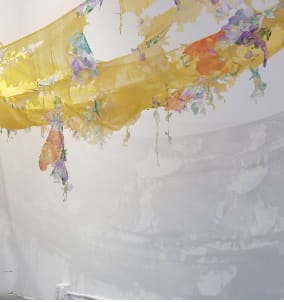
This exhibition is part of the Gaylord and Dorothy Donnelley Foundation Curatorial Fellowship in Partnership with CAC. Learn more about this partnership here
The Poetics of Relation
In Poétique de la Relation Martinican philosopher, poet, and writer Édouard Glissant makes an argument for opacity. Defined as “an alterity that is unquantifiable, a diversity that exceeds categories of identifiable difference,” Glissant insists that we must demand the right to opacity. He further expounds upon this thought explaining “the theory of difference is invaluable —it has allowed us to struggle against the reductive thought produced by the presumption of racial excellence or superiority.” In considering the widespread, even pervasive impulse toward transparency, Glissant suggested:
“there’s a basic injustice in the worldwide spread of the transparency and the projection of Western thought. Why must we evaluate people on the scale of the transparency of ideas proposed by the West? … As far as I’m concerned, a person has the right to be opaque. That doesn’t stop me from liking that person, it doesn’t stop me from working with him, hanging out with him, etc. A racist is someone who refuses what he doesn’t understand. I can accept what I don’t understand.”
According to Glissant, the lack of transparency assisted with the construction of the Other must be eliminated in favor of relation to all things, or tout-monde. While Glissant’s writings on opacity and relation are presented specifically as it pertains to post-colonial conditions in Martinique, these ideas have been applied to contemporary art theory and practices, as well. Most notably, curator Okwui Enwezor’s writings on the globalization of contemporary art consider the imposition of Western-based hierarchies and homogenization as referenced by Glissant. Enwezor explores the complexities of globalization in contemporary art and highlights the need for the creolization of cultures. In an essay entitled “The Post-Colonial Constellation: Contemporary Art in a State of Permanent Transition,” Enwezor reiterates the importance of “post-colonial history and theory for accurate understanding of the social and cultural temporality of late modernity.” He goes on to state:
“If I recommended the post-colonial paradigm for illuminating our reading of the fraught historical context from which that discourse of Modernism and contemporary art emerged, it is only to aim toward a maturity of the understanding of what art history and its supplementary practices can contribute today toward our knowledge of art.”
In other words, it is imperative that cross-cultural influences, within contemporary art practice, are not only recognized, but celebrated—for it is our differences that contribute to a more cohesive image of Modernity and contemporary art at large.
The artists featured in this exhibition uniquely approach their difference. They transform notions of domesticity and intimacy. By combining elements of kitsch with “high art”, public and private spaces, the artist simultaneously upend contrived ideas of wealth, labor, class and access. Likewise, the artists’ works recontextualize relationship dynamics, challenging self and societally-imposed boundaries. Through their multi-layered practices, each artist embraces, activates, and utilizes their specific contribution to contemporary art practice, positioning it against the often lauded “cishet,” or the white and male contemporary Art World, as the sole and dominant narrative. In this act of defiance, they demand to be counted and included, while not requesting to be understood, but rather considered.
Written by Sheridan Tucker Anderson



